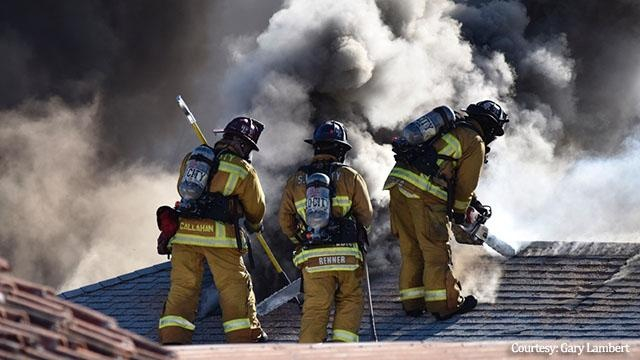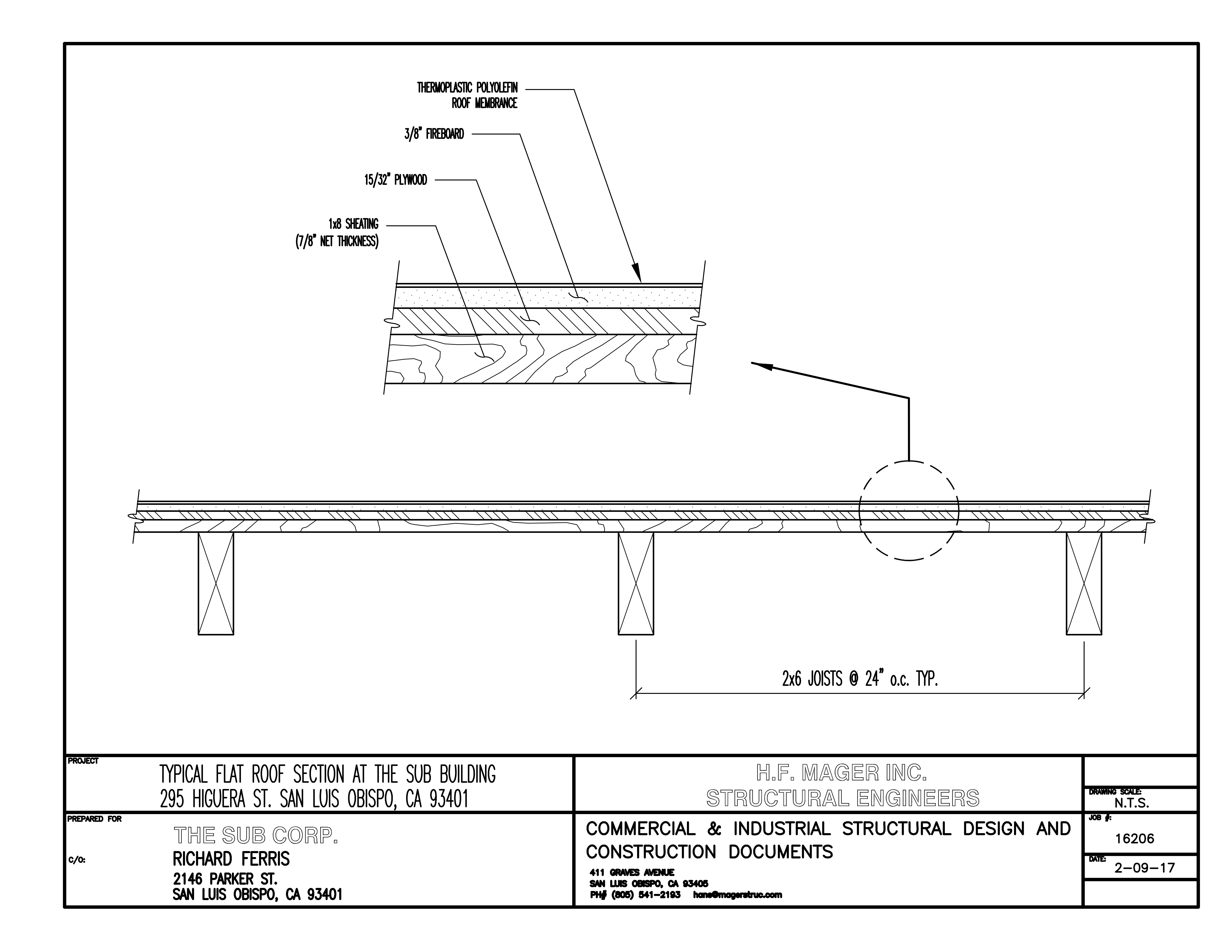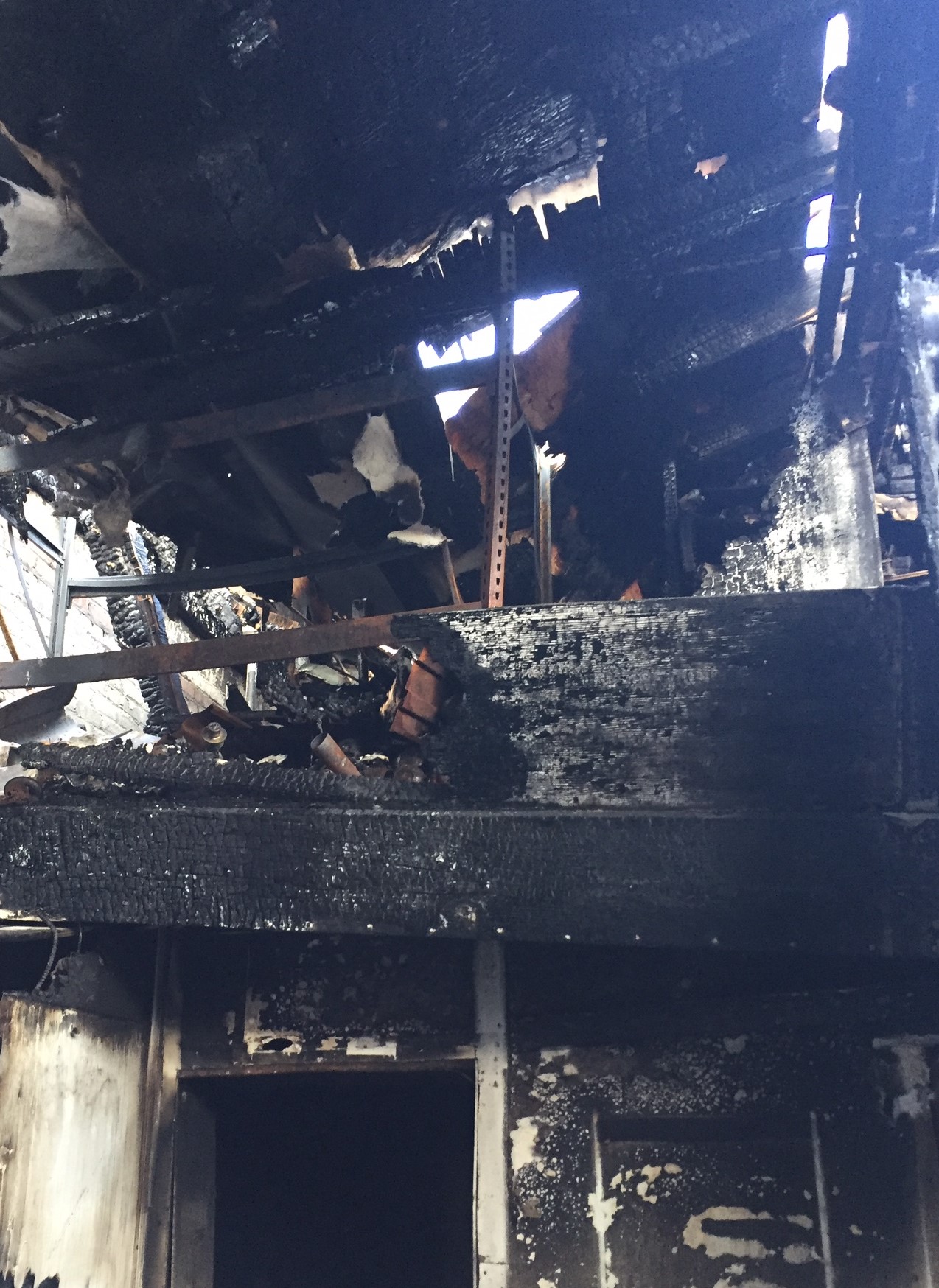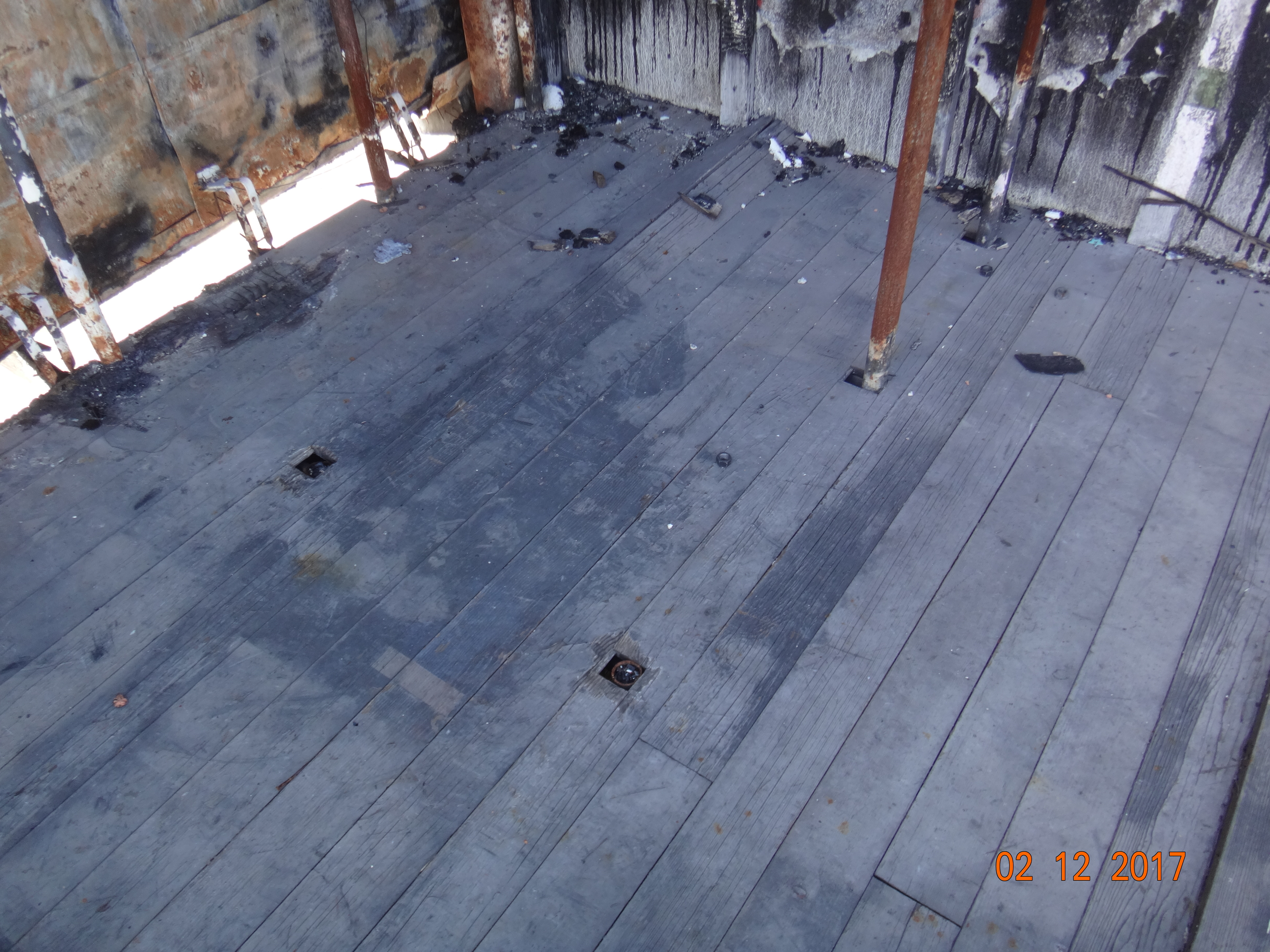The Sub Burndown
Saturday December 26, 2015
Section 1
- The Sub Fire -
 Above: Captain Matt Callahan cutting holes on both sides of interior firewall to help spread and intensify the fire. He knows no interior attack will be allowed.
Above: Captain Matt Callahan cutting holes on both sides of interior firewall to help spread and intensify the fire. He knows no interior attack will be allowed.
Intentionally Assisting In Burning A Building Down Is Not Firefighting (You Can't Put A Structure Fire Out With Chainsaws)
Allowing a fire in a display window box to spread and consume five buildings is not firefighting.
Burning through The Sub's roof:
The fire was burning and venting out through the still open louver above the front room in the front portion of The Sub. It was also venting out the access hatch that had been opened by firefighters on the roof over the front room. The fire was also venting out the main roof louver vent so there was no lack of ventilation to limit an interior attack. To have the fire move into The Sub's main room, SLOFD leadership put the fire hose through the center of the front door, opened up the roof, and put a master stream of water through the overhead opening in order to drive air to feed the fire on the underside of the roof. [see video: hose through door].
After 40 minutes (or more) of fanning the fire, SLOFD caused the fire to burn the rest of the way through the left portion of The Sub's roof.
Burn all roofs completely seemed to be the goal:
The sequence of photos showing the burning of 283 Higuera Street makes clear that SLOFD put no water on the fire until the roof was gone and almost everything was burned. This seems to be SLOFD leadership's policy. They let the blacklight room (283 Higuera Street) burn over 20 minutes before they would allow the two nearby hoses to put the fire out. When they did finally put water on the fire, it only took three seconds to put the fire out. [see video].
The metal building between The Sub main building and 283 Higuera Street, a former gas station building (not flammable) would not burn – SLOFD leadership broke all the windows and cut the sealed doorways in 283 Higuera Street to open it up for more air – but it was still not enough. They took a chainsaw to the Pismo Street wall and cut an 8' vertical slash in the wall to better fuel air to the fire. The reason to add air to the fire appears to be an attempt at burning the metal roof.
SLO City FD leadership appears to have caused most of the damage!
If SLOFD leadership had never taken over our fire scene and had done nothing, only The Sub would have burned.
We feel that a single volunteer fire truck and crew, if allowed to fight and engage this fire promptly, would have had the fire out in five minutes (except for mopping up)…
If only a volunteer fire company had arrived at our fire, and we would have only lost the front portion of The Sub.
By encouraging the merchandise and back wall in The Sub's main room to burn fiercely (with air blown in through the front door by a fire hose on spread pattern and the two draft holes above), the “fanned" fire burned through the wall separating The Sub from the poster/CD staging loft adjoining the main Square Deal Recordings & Supplies building. It came slowly as, at first, the piles of cassettes kept falling into the area where the wall was burning through while slowing it down.
All the extra air blown in acted like a bellows and increased that fire greatly, raising the fire temperature and causing it to burn through up into the cassette/CD staging loft behind SDRS.
Without the extra air blown in by the water hose through the front door and overhead master streams through roof openings, the wall between The Sub and SDRS would not have burned through. It took the continuous bellows effect of all the blown in air and total refusal of SLOFD leadership to put water on the clearly visible, easy-to-reach-from-the-outside fire (which was burning to the right of the front door) to cause the burn-through. (This was easily done even with a defensive strategy in place.)
The fire then burned along the underside of the loft roof and into the apartment at 150 Pismo Street (with the aid of a 4'x4' draft hole cut into the apartment roof along Pismo Street). If the apartment had been defended from the exterior through the two windows only, the fire could not have gotten through.
Finally, the fire burns into the back of SDRS into the poster room. If a pair of firemen had been stationed to monitor this, it could have been stopped with a garden hose.
At any time up to 90 minutes into the fire, one hose spraying the back interior wall of The Sub through the 100 Pismo Street door would have stopped the fire dead at this firewall. Even an unmanned ground monitor in the 100 Pismo Street beaded curtain display room or rear door of The Sub would have 100% stopped the fire from ever leaving The Sub main room.
When Richard Ferris (owner) asked Fire Chief Olson to do this and explained why, he was again ordered to stop interfering with public safety and threatened with arrest.
Section 2
- Square Deal Recordings & Supplies (SDRS) Fire -
Section 3
- San Luis Obispo City Fire Department (SLO City FD) Issues -
 Above: White roofing turns silver by UID #2 — flat roof still visible in debris pile — roof in corner still there.
Above: White roofing turns silver by UID #2 — flat roof still visible in debris pile — roof in corner still there.
Above: White roofing turns silver by UID #2 — flat roof still visible in debris pile — roof in corner still there.
Remains of roof in corner where UID #2 went off —
1. Most of flat roof is still unburned and in debris pile.
2. UID #2 burning on top of roof has turned the TPO roofing silver gray — only where UID 2 burned was the white TPO roofing turned silver gray which is consistent with an accelerant fire on top of the roof.
3. Plywood on burned back wall is burned and missing ONLY in location where we feel accelerant was poured onto roof.
An interior attack could have also been conducted by going into the cut open doors, or the front doorway of 283 Higuera Street (blacklight room), and putting water on any part of The Sub's main interior through the 36" doorway behind a 13" masonry firewall – a totally safe location from which to put water onto the fire. This building did not catch fire until over an hour later. There was no effort to defend either small structure at 283 Higuera Street.
At no point during the 12 hours of the fire did any water get put on the actual fire burning on the underside of the roofs or any merchandise burning in the building.
If we could have fought the fire ourselves with no help or interference from SLOFD, we would have 100%, for sure, saved all of SDRS and most of The Sub – Buckets of water, sheets of plywood, and people who cared would have done way better than SLOCF leadership did!
SLOFD leadership is taking up the space of actual professional firefighters. Until leadership is changed, they will victimize other San Luis Obispo residents to ensure their own safety, and ease of job, while claiming credit and glory for work they did not do.
VIDEO EVIDENCE
- Videos clearly show fire and white smoke is venting from the two open roof louvers just before UID #2 goes off [see video].
- UID #2 appears in the front corner (Side A/B of The Sub) on the flat portion of the roof. It goes from zero to full-blown in 60 seconds.
- UID #2 shows temperatures in videos that could only be achieved with an accelerant and would not be achieved if it was a fire projecting through the roof burning the wood, paper, and merchandise below [see video].
- The smoke venting from the actual fire just before UID #2 goes off is white and voluminous from the vent.
- The smoke from UID #2 is black, roiling, and sooty looking – like an accelerant.
- The parapet wall around the flat portion of The Sub's front roof is over 4' tall. So, when water is put over the parapet wall, it completely goes over the top of the fire (whether it is burning on top of or through the roof) and only has effect when it rolls back towards the roof drainage scupper. UID #2 on top of the roof is washed down the scupper drain in five seconds [see photo: The Sub roof structure] / see video: UID #2 washed down scupper].
- If the fire had burned through the roof, the water would not have washed the fire away – It would have fallen through the hole. This would not put out a large merchandise fire if it was burning underneath and it would have had no effect on a fire burning on the underside of the flat roof.
- Videos after UID #2 is out, show the fire returns to venting out the two roof louvers (and now the cut open roof hatch) and there is no sign of fire, smoke, or venting from the area UID #2 went off on top of [see video]. The Sub front peaked roof does not burn through for over an hour.
- When ladder truck T-1 started putting water into the open end roof louver that was venting the fire, a different hose was also pushing water and air in the front door. This created a positive pressure in The Sub and caused smoke to be pushed out from multiple openings in the front of The Sub, but no smoke or fire came from the former location of UID #2 – So, no hole could be in the roof or smoke would have been forced out. This means that UID #2 had to be on top of the roof not burning through [see video].
- Thermoplastic polyolefin (TPO) roofing does not melt until 1200°F. This means that non aerated wood will completely burn from underneath but, unless there is ventilation and air added to raise the temperature of the fire above 1200° F, it will not burn through the TPO roof membrane. Its normal failure mode is to tear when the roof structure collapses below it – This takes time!
- The fire took almost 12 minutes to burn across the roof to finally show venting out of the end of roof louver [see video]. (Sixteen minutes into the fire – but during the first four minutes, the fire was likely confined to the window box.) Since it took almost 12 minutes to burn unimpeded from the original seat of the fire to the vent, it would be impossible for it to have burned 8' or 10' past the vent on a lower portion of the roof (against the air flow going out the louver) then burn through ¾ 1x8, ½" plywood, 3/8" fireboard, and then through the TPO roofing in roughly the same time it took to just burn to the opening venting the fire at the end of the roof peak.
- TPO roofing discolors and turns a silver/gray when it has an immediate fire burning on top of it
- The TPO roofing left after the fire in the location of UID #2 was turned silver/gray. All other TPO roofing remained white after the fire [see TPO report and photos].
- In the photos of the debris where UID #2 went off, a large section of the original flat roof in the general area of UID #2 is seen in the debris pile fairly intact [see photo].
- The rest of the flat roof away from the front of The Sub remained after the fire. The view from underneath shows that with all the time the fire burned in The Sub, it did not burn through the flat roof. Two hours of fire does not burn 2/3 of the flat roof that remains so it would not be possible to burn through the flat roof under UID #2 in just the couple of minutes it would have had [see photo: roof section].
PHYSICAL EVIDENCE

Above: It would (and does in The Sub fire) take over an hour to burn through this type of roof located in a "dead" corner of the fire.
Actually, the fire NEVER does burn through the flat section of The Sub roof. When the front peaked roof fails around 12:30, it pulls the flat roof from the wall and leave it in the debris pile unburned.
Section 4
- Comments, Observations and Correction on Narratives by SLO City FD -
- Section 1 - The Sub Fire:
- 6 Minutes With The Arsonist
- Full Fire Investigation Never Done - Arson Investigation Refused
- Clearing The Building - Checking to Make Sure No One is Inside
- No R.I.T. or F.A.S.T. Crew Assigned
- The Sub Fire Load & Interior Details
- The Sub Roof Details
- Seven Path to Enter & Fight the Fire at The Sub
- Intentionally Assisting In Burning a Building Down is Not Firefighting
- UID #2 on Top of The Sub Roof Corner A/B
- See How the Fire Moved Through the Structures
- Section 2: Square Deal Recordings & Supplies Fire:
- The Sub Office Proves Fire Did Not Come Into The Front Of Square Deal Recordings & Supplies From The Sub Through The Firewall Between The Two Businesses
- Unknown Incendiary Device Number Three
- SDRS Fire Load Notes
- 11 Basic Stop Points for Preventing Fire Spread into SDRS from Rear
- Hole Map Illustration
- Section 3: San Luis Obispo City Fire Department (SLO City FD) Issues:
- SLOFD Fire Calls 2009-2016
- SLOFD Press Release Corrections
- Bravest Act or a Cowardly, Evil Act?
- Is BC-1 Berryman An Arsonist?
- Total Destruction is a Job Well Done
- SLOFD Fails to Follow Its Own Rules
- SLOFD Underground "Burndown" Policy
- Is SLO City FD a Corrupt Fire Department?
- How Can You Believe A Fire Department Would Help Burn A Building Rather Than Save It?
- Official CityGate Report Shows Major Fire Department Problems that City Leadership Continues to Ignore
- They Train For What They Actually Do, BURN Things Down Fast and Efficiently
- Is SLO City FD a Corrupt Fire Department?
- Letter From City Manager Derek Johnson - June 12, 2018
- Letter To City Manager Derek Johnson - July 26, 2018
- Letter From City Manager Derek Johnson - August 13, 2018
- Letter To City Manager Derek Johnson - August 17, 2018
- Letter To City Manager Derek Johnson - August 17, 2018 (#2)
- SLO City FD Actual Firefighter Strategy
- Official CityGate Report Shows Major Fire Department Problems that City Leadership Continues to Ignore
- They Train For What They Actually Do, BURN Things Down Fast and Efficiently
- Section 4: Comments, Observations, and Corrections to Narratives of SLOFD:
- SLO City Fire Department Continues to Fail Our City
- Narrative: Battalion Chief Neal Berryman
- Narrative: Deputy Chief Jeff Gater
- Narrative: Chief Garret Olson
- Narrative: Captain Michael King
- Narrative: Captain Mark Vasquez
- Narrative: Captain Matt Callahan
- Narrative: Captain Paramedic Station 3A David Marshall
- Section 5: Case Studies (Pattern of Conduct):
- Section 6: SLOFD Firefighter Narratives
- Section 7: SLOFD Fire Investigation Report
- Section 8: Arson Investigator /Expert Letters
- Section 9: Firefighting Info:
- Section 10: Original Unedited Video Material
- Section 11: Supplementary Material
- Cesar's Photos
- Ethan B.'s Photos
- Drones Images
- "Katie's Friend"s Photos
- Neighbor's Photos
- Jim M.'s Video
- Jimmy T.'s Video
- John I.'s Witness Videos
- KCOY Photos
- Logan C.'s Photos
- Michael H.'s Photos
- Nicole and Kjerstin's Photos
- Shar's Photos
- "PRR"'s Photos
- Sara S.'s Photos and Videos
- Final Report Videos
- Section 12: Actual Firefighting Action
- Section 13: What Real Ventilation Training Looks Like

